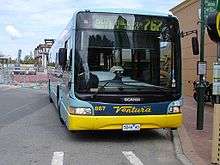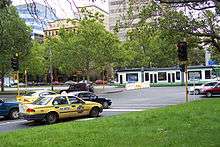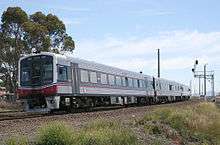Director of Public Transport
| Government Agency | |
| Predecessor | Public Transport Corporation |
| Successor | Public Transport Victoria |
| Founded | 1999 |
| Founder | Government of Victoria |
| Defunct | 2013 |
| Headquarters | Melbourne, Victoria, Australia |
Area served | Victoria |
Key people | Brandon Mack (final Director of Public Transport) |
| Services | Promote, provide, coordinate and regulate public transport in Victoria |

The Director of Public Transport (the Director or the DPT) was the head of the Public Transport Division (PTD) of the Victorian Department of Transport. PTD was the government agency responsible for promoting, providing, coordinating and regulating public transport in the State of Victoria, Australia between August 1999 and April 2012. The Director of Public Transport was created as a statutory office supported by staff of the Department of Transport.
The key responsibilities of the Director centred on the entering into and management of franchising contracts with train, tram and bus companies to provide public transport services in Melbourne and Victoria. The Director also had oversight of the Victorian Taxi Directorate which regulates the taxi and hire car industry in Victoria. As part of its operational functions, the DPT also had responsibilities relating to public transport planning and projects as well as the accreditation of passenger transport companies for enforcement purposes and the appointment and management of authorised officers for enforcement activities across Victoria's public transport system.
On 2 April 2012, the majority of the Director's functions were transferred to either the newly created Public Transport Victoria or the Secretary of the Department of Transport. The office of the Director of Public Transport was abolished on 1 July 2013.
Main responsibilities
Trains, trams and buses

The most prominent responsibilities of the Director of Public Transport concerned the franchising or contracting of transport operators to provide train, tram and bus services in Melbourne and regional Victoria. Accordingly, the Director was responsible for procuring services through operators, and entering into and managing franchise contracts. The key contracts managed by the office were:
- Trains in Melbourne (contract with Metro Trains Melbourne)- these services covered the provision of suburban rail services in Melbourne
- Trams in Melbourne (with Keolis Downer) - these services covered the provision of suburban tram and light rail services in Melbourne
- Trains in regional Victoria (with V/Line Corporation) - these services covered the provision of train services in country and regional Victoria
- Bus services in Melbourne and the rest of Victoria, including school bus services, with a large number of different bus operators.
Train and tram services in Victoria are governed by complex statutory, government and commercial relationships. VicTrack is the custodian of all rail infrastructure and assets in Victoria. VicTrack leased these to the Director of Public Transport through the Metropolitan Infrastructure Head Lease. The Director then sub-leased the assets to the metropolitan train and tram operators through Infrastructure Leases. The Director managed the rights and obligations contained in these leases on behalf of the State. The Director also entered into franchise agreements with the metropolitan train and tram operators that governed the provision of public transport passenger services. The franchise agreements specified a range of operational and service requirements administered and managed by the Director.
In relation to regional train services operated by V/Line Corporation, similar arrangements were entered into with VicTrack and the Director. VicTrack leased the regional train infrastructure and assets to the Director, who then sub-leased these assets to V/Line under the Regional Infrastructure Lease. Similarly, the Director and V/Line entered into a franchise agreement which governed the operational and service requirements for regional train services.

Taxis and hire cars
The Director of Public Transport was the regulator of taxi and hire car services in Victoria.[1] The Victorian Taxi Directorate (VTD) was a specialised Branch of the DPT and managed these services under delegation from the Director. The office of the Director, again through the VTD, was also responsible for the accreditation of commercial passenger vehicle drivers including taxi drivers.[2] The responsibilities were later conferred by delegation on the VTD from the Secretary of the Department of Transport but have been overseen by the Taxi Services Commission as of 1 July 2013.
Other responsibilities
The Director was also charged with the accreditation of passenger transport companies for enforcement purposes, and the appointment and management of authorised officers for enforcement across the public transport system.[3] The Director also had responsibility for regulating the appointment and activities of driving instructors and administering a compensation scheme for traumatised train drivers.[4] The responsibilities were later conferred by delegation on the VTD from the Secretary of the Department of Transport but since 1 July 2013 are the responsibility of the Taxi Services Commission.

Governance
Establishment
The office of the Director of Public Transport was established in 1999 following the passage of the Rail Corporations (Further Amendment) Act 1998 through the Victorian Parliament.[5] This Act effectively privatised those aspects of the operation of public transport in Victoria which were not already provided directly by private companies. On 24 August 1999, the Director effectively took over responsibility for public transport in Victoria from the former Public Transport Corporation, which had been a statutory authority responsible for operating a large proportion of Victoria's public transport services.
The Rail Corporations (Further Amendment) Act inserted provisions[6] into the then Transport Act 1983[7] to create the office and its functions and powers. The office of the DPT was later re-established under the Transport Integration Act 2010.[8]
Transport Integration Act
The Transport Integration Act provided the Director of Public Transport with new objects, functions and powers on 1 July 2010.
Objects
The Transport Integration Act provided that the primary object of the Director of Public Transport was to "...provide, operate and maintain the public transport system...".[9] Other notable objects[10] of the Director included:
- ensuring, in collaboration with other transport bodies and public entities, that public transport operates as part of an integrated transport system which seeks to meet the needs of all transport system users
- managing public transport in a manner which supports sustainability by seeking to increase the share of public transport trips as a proportion of all transport trips in Victoria
- seeking to improve the environmental performance of public transport including by minimising its adverse environmental impacts
- contributing to social well-being by providing access to opportunities and supporting liveable communities
- promoting economic prosperity through efficient and reliable movement of public transport users while also supporting rail freight services
- improving the safety of public transport for public transport users.
Functions
The functions[11] of the Director of Public Transport included:
- constructing, maintaining or varying public transport infrastructure
- planning for the public transport system
- providing, operating or facilitating public transport including by entering or managing contracts for public transport services and purchasing and maintaining rolling stock
- developing policies and strategies to improve safety and security on the public transport system
- developing and implementing policies, plans and guidelines
- providing licensing and accreditation services
- monitoring and reporting on contractual performance.
Powers
The general and specific powers[12] of the Director of Public Transport included a broad range of powers in relation to land, contracting, rolling stock, tree clearance, breaking up roads, installing stopping places, closure of level crossings, stopping of traffic, etc.
Other Victorian transport agencies
There are a range of State agencies responsible for the transport system in Victoria. The Department of Transport (DOT) oversees and coordinates the activities of the agencies which can be divided into three main types - statutory offices, statutory authorities and independent transport safety agencies. Together with DOT, the agencies provide, manage and regulate transport system activities in Victoria including:
- heavy and light rail systems including trains and trams
- roads systems and vehicles including cars, trucks and bicycles
- ports and waterways including commercial ships[13] and recreational vessels
- some air transport systems.[14]
Statutory office
The statutory office is the Transport Infrastructure Development Agent[15]
Statutory authorities
The statutory authorities[16] are:
- the Roads Corporation (VicRoads)
- Public Transport Victoria
- Victorian Rail Track Corporation (VicTrack)
- V/Line Corporation (V/Line)
- Taxi Services Commission
- the Linking Melbourne Authority
- the Port of Melbourne Corporation
- the Port of Hastings Development Authority
- the Victorian Regional Channels Authority
- the Transport Ticketing Authority
- the Regional Rail Link Authority.
Many of these agencies are more or less separate from the Department of Transport.[17]
Independent transport safety agencies
The independent transport safety agencies[18] are:
- the Director, Transport Safety (Transport Safety Victoria)
- the Chief Investigator, Transport Safety.
These agencies are part of the Department of Transport but are functionally independent and report to the relevant Ministers.[19]
Abolition of the Director of Public Transport

The office of Director of Public Transport was phased out by the state government following the Victorian state election in November 2010. The Transport Legislation Amendment (Taxi Services Reform and Other Matters) Act 2011 transferred direct responsibility for taxi and small commercial passenger vehicle services from the Director to the Secretary of the Department of Transport. That was essentially a transitional step before the activities were assumed by the Taxi Services Commission established by that Act. The Commission took over regulatory control of taxis and hire cars on 1 July 2013. More broadly, the Director's responsibility for the provision of train, tram and bus services across Victoria were transferred to Public Transport Victoria on 2 April 2012. The office of the Director of Public Transport was finally abolished on 1 July 2013.[20]
See also


- Rail Transport in Victoria
- Railways in Melbourne
- Trams in Melbourne
- Buses in Melbourne
- Department of Transport
- Transport Integration Act
- Director, Transport Safety
- Chief Investigator, Transport Safety
- Public Transport Victoria
- Taxi Industry Inquiry
- Taxi Services Commission
- Transport Act 1983
- Transport (Compliance and Miscellaneous) Act 1983
- Transport Legislation Amendment (Taxi Services Reform and Other Matters) Act 2011
References
- ↑ See Part 6, Transport (Compliance and Miscellaneous) Act 1983.
- ↑ Drivers of taxis, hire cars and buses. This was provided in Part 6 of the Transport (Compliance and Miscellaneous) Act 1983.
- ↑ See Part 7, Transport (Compliance and Miscellaneous) Act 1983.
- ↑ See section 12, Transport (Compliance and Miscellaneous) Act 1983.
- ↑ Record of the progress of the Bill through the Victorian Parliament.
- ↑ See former subdivision 2 of Part II of the former Transport Act 1983.
- ↑ This Act was renamed from 1 July 2010 the Transport (Compliance and Miscellaneous) Act 1983 by the Transport Integration Act 2010.
- ↑ See Division 1 of Part 5 of the Transport Integration Act 2010.
- ↑ Section 66(1), Transport Integration Act.
- ↑ Section 66(2), Transport Integration Act 2010.
- ↑ See section 67, Transport Integration Act 2010.
- ↑ Sections 68-72 of the Transport Integration Act 2010. A number of specific powers of the Director were retained in its former establishing statute, the Transport (Compliance and Miscellaneous) Act 1983 (previously named the Transport Act 1983) - see sections 9C to 12.
- ↑ Note, some shipping matters are controlled by the Commonwealth under legislation such as the Navigation Act 1912. Other matters are within the jurisdiction of States such as Victoria through Acts such as the Transport Integration Act and other statutes like the Marine Act 1988.
- ↑ Note, many air transport regulation matters are controlled by the Commonwealth Government. The Transport Integration Act would apply, for example, to planning controls at some airports and in respect of transport connections to other airports by road and rail.
- ↑ The charter and powers of the Transport Infrastructure Development Agent are set out in Division 4 of Part 3 of the Transport Integration Act 2010.
- ↑ See Parts 5 and 6, Transport Integration Act 2010
- ↑ The Act establishes these agencies as structurally separate bodies with their own legal personality. For example, section 81(4) of the Transport Integration Act 2010 establishes VicRoads as a "body corporate" which "may do and suffer all acts and things that a body corporate may by law do and suffer".
- ↑ Part 7, Transport Integration Act 2010.
- ↑ Section 194, Transport Integration Act 2010.
- ↑ Transport Legislation Amendment (Public Transport Development Authority) Act 2011.
